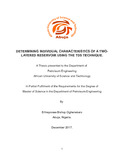| dc.contributor.author | Erhieyovwe, Bishop Oghenekaro | |
| dc.date.accessioned | 2019-08-27T15:08:51Z | |
| dc.date.available | 2019-08-27T15:08:51Z | |
| dc.date.issued | 2017-12-12 | |
| dc.identifier.uri | http://repository.aust.edu.ng/xmlui/handle/123456789/4921 | |
| dc.description.abstract | The first part of this study discussed in details the two major model that was developed for the study of a multilayer reservoir system. They are the Dual permeability model proposed by Bourdet and the semipermeability wall model proposed by Gao. The pressure response of a crossflow system is observed in three stages; it behaves as a commingled system in the early stage and then as a single layer homogenous system in the late stage. There is a transition stage, which connects the early and late stages. The effect of some reservoir parameters such as the permeability thickness ratio, the storativity ratio and the semipermeability was studied.
The second part of this study focused on a two-layer reservoir system with crossflow when only one layer is perforated and tested. The pressure response for this test method was observed to have two infinite acting straight line on which the TDS technique was developed to determine the individual layer parameters such as permeability thickness for both layers, wellbore storage and skin effect for the perforated layer. | en_US |
| dc.description.sponsorship | AUST and AfDB. | en_US |
| dc.language.iso | en | en_US |
| dc.subject | Erhieyovwe Bishop Oghenekaro | en_US |
| dc.subject | 2017 Petroleum Engineering Theses | en_US |
| dc.subject | Prof. Djebbar Tiab | en_US |
| dc.subject | Crossflow | en_US |
| dc.subject | multilayer | en_US |
| dc.subject | TDS | en_US |
| dc.title | Determining Individual Characteristics of a Two-Layered Reservoir using the Tds Technique | en_US |
| dc.type | Thesis | en_US |

